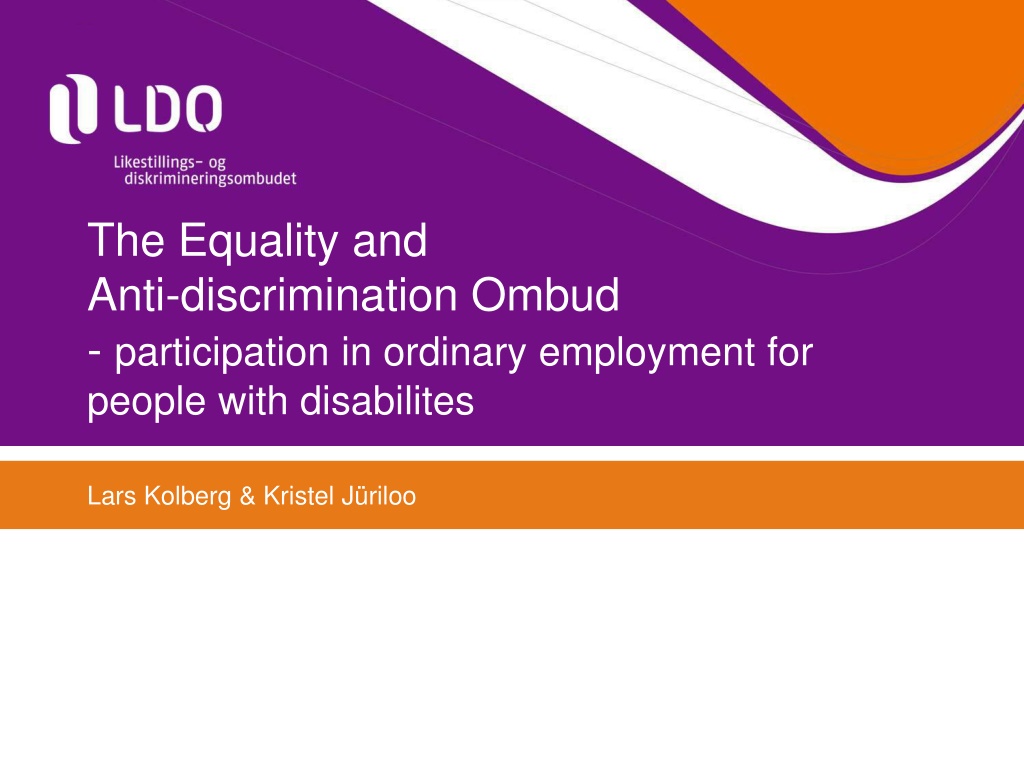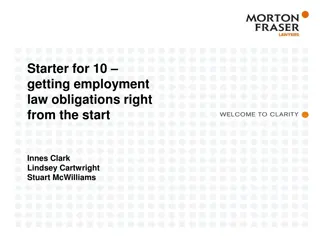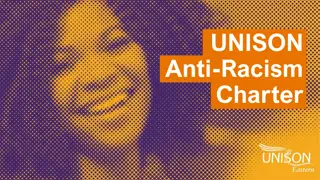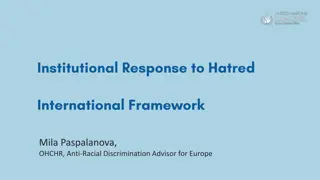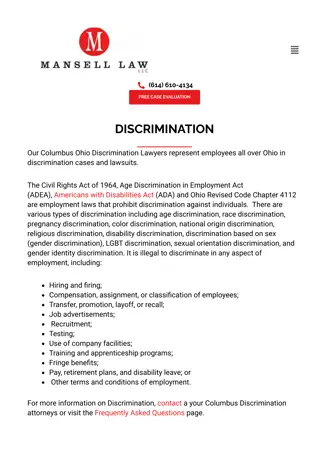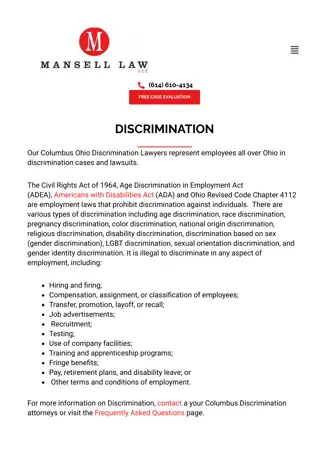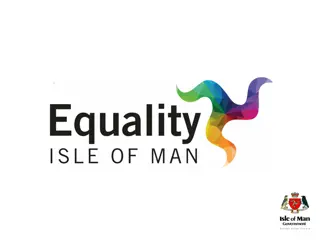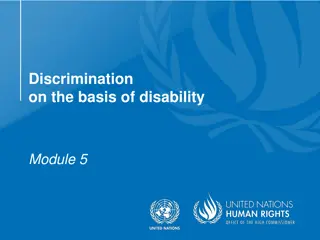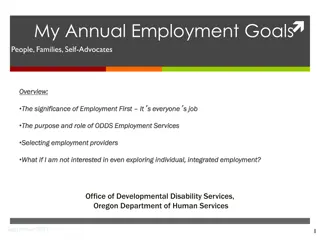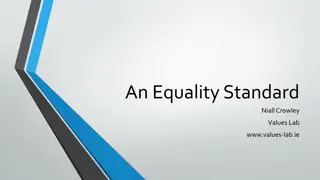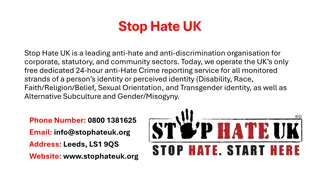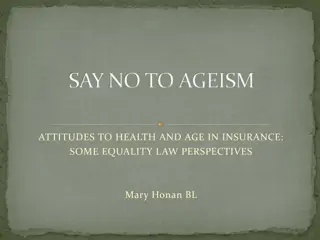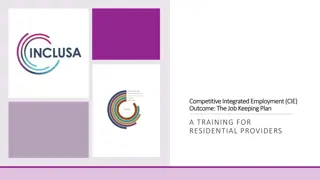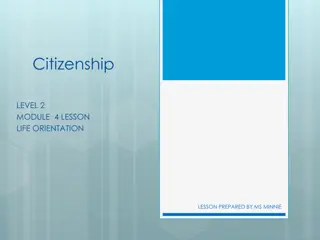Ensuring Equality and Anti-Discrimination in Employment: The Ombud's Role
The Equality and Anti-Discrimination Ombud plays a crucial role in promoting ordinary employment opportunities for individuals with disabilities. Established in 2006, the Ombud integrates various offices and operates independently under the Ministry of Children, Equality, and Inclusion. It acts as a law enforcer, offering legal advice, handling complaints, and providing guidance to both employers and employees. The Ombud issues statements of opinion, although these are not legally binding and can be appealed to the Equality and Anti-Discrimination Tribunal or overruled by civil courts. The Ombud's jurisdiction covers a wide range of areas including gender, ethnicity, religion, belief, disabilities, sexual orientation, political views, and age, with a focus on ensuring equality and accessibility in all aspects of society.
Download Presentation

Please find below an Image/Link to download the presentation.
The content on the website is provided AS IS for your information and personal use only. It may not be sold, licensed, or shared on other websites without obtaining consent from the author. Download presentation by click this link. If you encounter any issues during the download, it is possible that the publisher has removed the file from their server.
E N D
Presentation Transcript
The Equality and Anti-discrimination Ombud - participation in ordinary employment for people with disabilites Lars Kolberg & Kristel J riloo
The Ombud - structure and organisation Established 1 January 2006 through the Anti- Discrimination Ombud Act Integrates three former offices Under the Ministry of Children, Equality and Inclusion An independent public administrative agency Operates free from the instruction of the Ministry
The Ombuds office Ombud Sunniva rstavik Law Administration and HR Monitoring conventions Guidance Communication enforcement CEDAW Law enforcement legal advice on questions of law Administration Information CERD Statements of opinions Human Resources Forum CRPD Information Public hearings Media Monitoring Guidance to employers Economy Web Reporting Public hearings Likestillings- og diskrimineringsombudet
LDO as a law enforcer An alternative to courts of law Free of charge Handles complaints about breaches of law Gives legal advice Also take on cases by own initiative Procedural features: The principle of contradiction Shared burden of proof: presumption/ rebuttal Likestillings- og diskrimineringsombudet
The Ombuds statements of opinion Not legally binding No power to sanction our opinions Statements can be appealed to The Equality and Anti-Discrimination Tribunal Civil Courts can overrule Likestillings- og diskrimineringsombudet
The Anti-discrimination legislation Gender Equality Act 2013 Anti- Discrimination on Ethnicity Act 2013 Anti- Discrimination and Accessibility Act 2013 Anti- Discrimination Act on Sexual Orientation 2013 Working Environment Act Chapter 13 Gender All areas of society Ethnicity (national origin, descent, skin colour, language) Religion Belief Disabilities All areas of society Sexual orientation Gender expression Gender identity All areas of society Political view Membership in labour organisations Age In cases of employment only Likestillings- og diskrimineringsombudet
Statistics 2014 Guidance: 1430 Complaints (resulting in decisions): 207 Majority of cases are connected to employment/working life Disability is the second most common discrimination ground in these cases
Number of complaints regarding disability 200 180 160 140 120 100 80 60 40 20 0 2007 2008 2009 2010 2011 2012 2013
Complaints regarding disability 160 140 120 Employment Goods and services Public administration Education Housing Police, justice system Other 100 80 60 40 20 0 2007 2008 2009 2010 2011 2012 2013
Number of inquiries regarding disability 600 500 400 300 200 100 0 2007 2008 2009 2010 2011 2012 2013
Inquiries regarding disability 180 160 140 Goods and services Employment Other Public administration Education Housing Police, justice system 120 100 80 60 40 20 0 2007 2008 2009 2010 2011 2012 2013
The Anti- Discrimination and Accessibility Act Main elements: Prohibition of direct and indirect differential treatment Exception if the differential treatment is legitimate, necessary and proportionate Affirmative/Positive action
The Anti- Discrimination and Accessibility Act Main elements: Public and private entities open to the public have a duty to ensure universal design (exception: undue burden) Right to individual accommodation in education, employment, the kindergarten and of long-lasting public health and social services (exception: undue burden) Likestillings- og diskrimineringsombudet
The Anti- Discrimination and Accessibility Act 26 Right to individual accommodation Employees and applicants with a disability have a right to reasonable individual accommodation of the place of employment and their work tasks in order to ensure that they can obtain or continue employment, have access to vocational training and other development of their qualifications, and to be able to perform their tasks and have the opportunity to be promoted on an equal basis with others. Likestillings- og diskrimineringsombudet
The Anti- Discrimination and Accessibility Act 26 The right to individual accommodation is limited to accommodation that is not an undue burden. In this assessment one should particularly take into account the effect of the accommodation on building down barriers, the necessary costs of the accommodation and the resources of the entity. Likestillings- og diskrimineringsombudet
Paradox? Unemployment rate is much higher also w/ higher education 85-90000 persons with disability want to work. Many (state) employers are actively seeking persons with disabilities. Unsucsessful. Misfit?
What happens in recruitment? Ansatt Tilbud Innstilt Intervju 2 Intervju S ker Discrimination you have to discriminate between candidates in order to find one! Risk-averse employers => less diversity
What is the consequence? Bad for diversity inequality / lack of diversity some groups always underrepresented Segregated and clustered labour market Bad for business Homogenity we are all the same Less dynamics, less creativity etc. Broad agreement on this in Norway
What employers are required to do Positive duty: All employers* are required to promote equality combat discrimination on gender, ethnicity and disability * all public employers and private >50
What can employers do? Fight my inherent tendency to employ someone similar to me
Good recruitment Find out what I need - really Assess applicants on whether they meet the actual qualifications for the position Choose candidates on the basis of these criterias without a view to other aspects age, gender, religion, disability = Equal recruitment good for diversity
Job Advertising Interview Selection analysis
Positive action in general Legal for all grounds - possibility Restricted for men (only position w/child care) Promote equal opportunities, proportional, temporary Conditions: In national discrimination law In collective agreements, regulations etc.
Positive action Encourage to apply Selection to interview Preferential treatment in hiring Weak and strong Trainee positions What is legal has moderate effects. What works tends to be illegal
